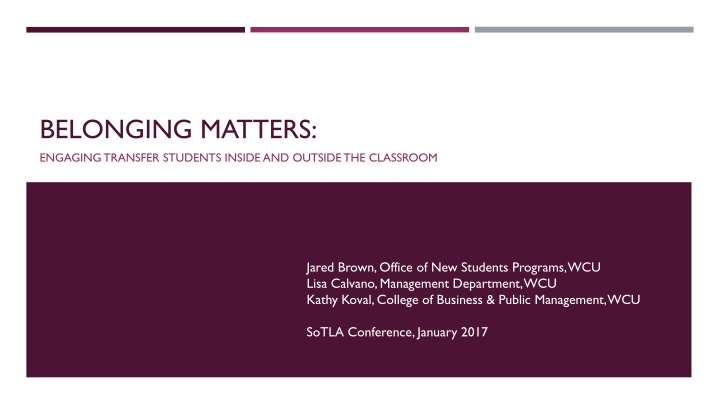
Transfer Students: Initiatives and Challenges in Higher Education
Explore the dynamics of transfer students in the academic landscape, uncovering reasons for transfer, differences from first-year students, and frustrations faced. Delve into research on transfer trends, retention initiatives, and best practices for engaging transfer students effectively inside and outside the classroom.
Download Presentation

Please find below an Image/Link to download the presentation.
The content on the website is provided AS IS for your information and personal use only. It may not be sold, licensed, or shared on other websites without obtaining consent from the author. If you encounter any issues during the download, it is possible that the publisher has removed the file from their server.
You are allowed to download the files provided on this website for personal or commercial use, subject to the condition that they are used lawfully. All files are the property of their respective owners.
The content on the website is provided AS IS for your information and personal use only. It may not be sold, licensed, or shared on other websites without obtaining consent from the author.
E N D
Presentation Transcript
BELONGING MATTERS: ENGAGING TRANSFER STUDENTS INSIDE AND OUTSIDE THE CLASSROOM Jared Brown, Office of New Students Programs, WCU Lisa Calvano, Management Department, WCU Kathy Koval, College of Business & Public Management, WCU SoTLA Conference, January 2017
AGENDA Introduction Discussion Current research & WCU trends Discussion Transfer retention initiatives at WCU Lessons learned & best practices Q & A
DISCUSSION QUESTIONS Why do students transfer? How do transfers differ from first-year students? What are the top frustrations of transfers students?
TRANSFER STUDENTS Highereducationtoday.org
TRANSFER STUDENTS Students Enrolled in 2-year college immediately following high school 30 25 20 15 10 5 0 1975 2011 Jacobs, B. (2008, January) Transfer Orientation. Session presented at Annual National Orientation Directors Association Conference, Boston, MA. National Center for Education Statistics (2007). The condition of education. Washington, DC: Bureau of Postsecondary Education.
TRANSFER STUDENTS AT WCU About 50% of WCU s transfer students are coming from a community college & the other 50% are coming from a traditional four year institution About 40%+ of WCU s graduates are transfer students
WHO ARE TRANSFER STUDENTS? Traditional Lateral Reverse Swirling Transferring from a four year to a two year and vice versa Transferring during the sophomore year is most common Out-of-state students transfer to another state Summer Swirlers enrolled in a four year school, but during the summer take courses at a community college. Zino, Dominique New Report on Student Transfer Patterns Reveals Complex Picture of How Students move Between Two-Year and Four- Year Colleges, Sept. 25. 2015 Jacobs, B. (2004).The college transfer student in America: The forgotten student. Washington, DC: American Association of Collegiate Registrars and Admissions Officers.
RESEARCH AT WCU The Counseling & Psychological Services at WCU has seen an increase of transfer students utilizing counseling services. Dr. Rachel Daltry and Dr. Kristin Mehr conducted a research regarding this increase and found that transfer students faced unique challenges that were different than the traditional first-year student: Living away from home for the first time New challenging course work New Social situations and opportunities Transfer students experienced an unsatisfying situation at their previous institution
RESEARCH AT WCU August 2016: New Transfer Students who attended a one-day orientation program were asked what has been most frustrating up to this point being new to WCU. These were the top three responses: 1. Scheduling for classes 2. Transfer credit process 3. *Meeting new people
THINK ABOUT IT Students in transition need to know not only the campus resources that are available and how to access them, but also that successful students seek out those resources. Make it easy for new students to find and access the resources to assist with their transition. New Transfer Students should be a priority not an afterthought. Thriving in Transition, Louis, Schreiner, Nelson (2012)
TRANSFER STUDENTS SHOULD MATTER! Marginality and Mattering theory (1989), Nancy Schlossberg Think about it According to Schlossberg, A sense of not fitting in or feelings of marginality often occur when individuals take on new roles. This is often true for transfer students. They should Matter According to Schlossberg Attention- Do we recognize our transfer student population Importance- Do we show that that we care by highlighting services for them Ego Extension- If they achieve, they are more likely to continue at WCU Dependence- the feeling of feeling needed Appreciation- the feeling that ones efforts are appreciated by others
DISCUSSION QUESTIONS How can we help transfer students make better connections? How do we figure out which transfer students are at-risk?
TRANSFER STUDENTS SHOULD MATTER! This is what we are doing to improve the feeling of mattering for new transfer students at WCU
TRANSFER INITIATIVES Intake questionnaire & proactive advising Dedicated business tutors Fall fair Business counselor participation in New Student Orientation Transfer focus groups Dedicated faculty advisor for declared majors University transfer initiatives Transfer Concierge, extended orientation, D2L orientation
LESSONS LEARNED & BEST PRACTICES Partnership of the Management Department, pre-business counselors and the Office of New Student Programs Develop connections and increase communication across divisions. Establish more touch points that connect transfer students to the university and their colleges and departments Create a holding environment where the message is we care and you matter
BELONGING MATTERS "The holding environment idea was developed by British psychoanalyst D.W. Winnicott (1965) to describe the nature of effective caregiving relationships between mothers and infants...Winnicott and others further used the concept to describe the analytic setting...This dynamic has been broadened from therapeutic institutions to other sorts of organizations In their most effective moments such relationships are temporary holding environments in which people floundering in anxiety are caught up and secured by others--calmed, appreciated, understood, helped--until they are able to regain their equilibrium and continue on their way." (Kahn, 2001, pp.1-2) Kahn, W.A. (2005) Holding environments at work. The Journal of Applied Behavioral Science, 37(3), 260-279.
